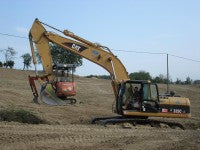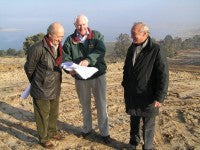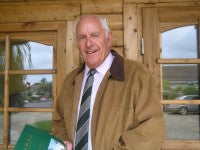Constructing golf courses
 Brian Pierson has been constucting golf courses for over forty-two years and, in that time, he has seen many changes, met some interesting folk, and dug a few holes where he shouldn't have!
Brian Pierson has been constucting golf courses for over forty-two years and, in that time, he has seen many changes, met some interesting folk, and dug a few holes where he shouldn't have!
Here, he relates a few interesting stories and gives his views on where golf is going or, rather, where he thinks it
should be going!
With the world economy in chaos, I have been asked for my thoughts after four decades in the golf course construction industry to give my view.
Golf course construction has always been more 'boom and bust' than the rest of our economy. The last boom period in the United Kingdom was in the late eighties and early nineties, unfortunately resulting in too many courses being built in the wrong place, at the wrong cost and, in many cases, to the wrong specifications. The UK has enjoyed a fairly steady period of construction since then.
However, the main thrust of construction has been in mainland Europe and, in particular, in the old eastern block countries. It would have been easier to write this article twelve months ago, although its accuracy would have been called severely into question following recent world events in the financial sector.
The main European developments tend to follow the Americans' format in which peripheral housing funds the construction. We have seen over the last few years many courses constructed in the new Europe using this method of financing, unfortunately the recent dramatic fall in property values has resulted in many of the new developments being halted or severely curtailed. In this business one never knows what's going to happen.
In February last year, I got a call in from Donald Steel. A mutual friend, Peter Ballingall, whom Donald and I first met when we built Barnham Broom Second Course, rang asking if we could provide a project manager on a new project in Spain.
Via email I was able to get in touch immediately and, six days later, I was on a plane to Madrid. I hired a car and drove a hundred miles towards Portugal, located the site and met with the client. Twenty-four hours later we had a signed contract for the Valdecanas project.
A week later my shaper went in on a sixteen week contract just to clear the site and, thirteen months later, after a very successful construction of greens, tees, fairways and bunkers, the project is now ready to be finished off.
I've done the doom and gloom bit and thought I could share a few of my ramblings with you.
I started constructing golf courses forty-two years ago. One of the first was with the late Hamilton-Stutt. I shall never forget in those days we used to rake out the formations to perfect levels before we even introduced stone carpets. We are standing looking at one particular thing and Hamilton says, "I think the mound on the right needs more material."
So I said to the foreman , "Go and get a dumper-load of material."
"No, no," said Hamilton, "not a dumper-load."
So I said, "Get a couple of wheelbarrow loads."
"No,no, no."
I said, "Two shovelfuls?"
He said, "Yeh, I think that'll do." Thank heaven we don't have that sort of incident too often!
Whilst talking of Hamilton-Stutt, a story that he used to tell against himself happened when we were building the Woodbury Golf Course. Hamilton sent his wife down to the dogleg, asking her to stand there with the umbrella raised so that he could get a feel for the tee. Subsequently when he got back for lunch, he was surprised that his wife was not back at the hotel and realised that he'd left her on the golf course. He went back and dutifully she was still standing holding the umbrella!
 I have had the privilege of working with Donald Steel for over thirty years and was asked to meet his client, Peter de Savary, to discuss the construction of the Carnegie Links at Skibo Castle, which Peter had recently bought. This is the original home of Andrew Carnegie, the wealthiest man in the world who donated more than 3,000 libraries worldwide. How strange that Skibo is now more famous because Madonna held her wedding there.
I have had the privilege of working with Donald Steel for over thirty years and was asked to meet his client, Peter de Savary, to discuss the construction of the Carnegie Links at Skibo Castle, which Peter had recently bought. This is the original home of Andrew Carnegie, the wealthiest man in the world who donated more than 3,000 libraries worldwide. How strange that Skibo is now more famous because Madonna held her wedding there.
I negotiated a contract with PdeS to carry out the construction of the first course. I arranged to meet Donald with Peter at the castle and arrived late one evening to set things in motion, having already sent up my equipment from the south of England. On arrival at 10.00pm I was met by a serious faced PdeS and told that the wind had blown down a wall and all my equipment had been crushed!
I spent a sleepless night, got up very early the next morning, drove all round the estate and finally located my equipment - hidden safely in one of his barns! At breakfast I initially went along with the ruse and we then enjoyed a good laugh.
Working with PdeS was great fun. He rang me a couple of years later to say would I go to America to look at a job in Newport, Rhode Island. "I'm not going to pay you a fee," he said, "but you can stay in my house." My wife and I arrived at Boston Airport in the most appalling weather, hired a car and set off and, in her words, "with the best directions possible, within four miles we were lost."
We turned into a petrol station with the comforting words from Ann, "at least they speak English here." With a Mexican and a Russian trying to talk to me, they soon recognised my clear Scottish accent and, with sign language, sent me back on the road to Bellevue Avenue, famous for the "We Will Walk Up the Avenue" song. Peter had bought one of the mansions and we spent a most enjoyable week pretending we were the Rockefellers.
The golf course project took over a year to obtain all the necessary planning consents and, in the meantime, I was asked to go to South Carolina where PdeS had purchased three and a half thousand acres in the Ace Basin, where Donald Steel had designed a very challenging 1 8-hole course.
8-hole course.
Off I go to the States, a couple of flight changes, hire a car and arrive at the Cherokee Plantation, complete with its 'Gone With The Wind' style mansion, where I am charged with putting together a costing. The next day it's down to Hilton Head, home of more golf courses in six or seven miles than I'd seen in the last six or seven years. I located a local contractor and asked if he would come and do some trial holes.
Without hesitation he said, "I'll be there at seven" and, with great excitement, we dug fifty or sixty trial holes throughout the plantation, noting soil types.
Then it was back on the plane to the UK, to be greeted with a ferocious call from PdeS saying, "What have you done at Cherokee Plantation? The owner says there are holes everywhere!"
"But, Peter," I said, "you said it was your land!"
"I haven't bought it yet!" was his reply.
We overcame the difficulties and purchased the estate and, with the help of a local contractor and twenty-six Mexicans, we constructed an exceptional course on which The Wonderful World of Shell Golf was played twelve months to the day from our start on site.
I recently attended the Ogro Conference in Kent, collecting en route, OGRO (Organisation of Golf Range Operators) President John Jacobs. We spent two happy hours driving down and swopping old stories.
The Conference was extremely well supported and, listening to the very interesting speeches, the main thrust of the day seemed to be bringing on junior golf but, most of all, providing fun for golfers visiting golf driving ranges.
My perception for many years of a golf driving range was a shed at the end of the practice ground with a mat and a few balls. I was so wrong. Today, many golf driving ranges could best be described as centres of excellence as they offer a wide variety of facilities encouraging golfers and families to enjoy fine dining and a relaxed family atmosphere whilst, in many cases, driving micro-chipped balls which tell you exactly where you and your partner's balls have landed.
Colin Jenkins and his team provided delegates with an extremely interesting and relaxed day, culminating in the presentation to Peter Alliss of a Lifetime Achievement Award. These concepts are perhaps ideas that could be adopted in traditional golf clubs wherever appropriate.
The changing face of golf course membership is becoming a serious issue and something that needs addressing.
 I have recently attended the European Golf Course Owners Association meeting in Berlin. The conference was styled 'The Big Change,' an appropriate title when the main thrust of the conference was the ever-changing needs and aspirations of golf club members, more and more of whom are forsaking their annual membership, wishing more to play at differing venues.
I have recently attended the European Golf Course Owners Association meeting in Berlin. The conference was styled 'The Big Change,' an appropriate title when the main thrust of the conference was the ever-changing needs and aspirations of golf club members, more and more of whom are forsaking their annual membership, wishing more to play at differing venues.
The feeling from the conference was that there was a strong possibility that traditional golf club membership would decline rapidly, and that the new golfer would now aspire to play as many different golf courses as possible, with the result that clubs must look to these nomadic golfers and provide what the golfer wanted, rather than the established format of most member clubs.
My overall impression from attending recent conferences is that golf has to become more fun. It has to become less time-consuming and it has to become more family orientated. We need to grow the next generation of golfers and there are many initiatives for junior golf including introductions to schools of the game.
What does appear to be lacking is coordination. One speaker at the Agro Conference drew attention to the total disparity in funding for the game, compared with many other organisations who, under a single governing body, appear to have got their act together and are receiving extremely generous grants from various government-funded initiatives.
In my capacity as Chairman of the British Association of Golf Course Constructors (BAGCC), I was disturbed to learn that funding for the GTC (the Greenkeeper Training Committee), under the dedicated guidance of David Golding, is struggling for funding.
We at BAGCC have long recognised that we build golf courses, it is the dedicated greenkeepers who turn them into golf courses, and I cannot believe that there is not a golfer in this country who would not willingly donate the cost of one golf ball to the GTC who place over 2,000 aspiring greenkeepers into the colleges every year, and yet I am reliably informed that the budget for the GTC is pence per UK golfer.
All of us in golf need to recognise that, without the new breed of young golfers, coupled with the present day dedicated greenkeepers, the game will suffer in the long term.
In talking of greenkeeping, it would be remiss of me not to refer to my dear departed friend and mentor, Jim Arthur, who, at our first meeting, said that "as my intended career was golf course construction, the most you can achieve is to aspire is to be the best of a bad bunch".
His words have stayed with me throughout my construction career. His book, Practical Greenkeeping, should be read by every golfer, not just those associated with greenkeeping, as it is packed with common sense. It is pleasing in these greener times that the leaders of our industry are now very conscious of sustainable golf and are actively encouraging golf clubs to move in the direction that Jim Arthur strived to introduce in his lifetime, dedicated to common sense and practical greenkeeping.
In summary, where do I see construction, membership and indeed the game going in the foreseeable future? On the downside, memberships are falling and there are many golf courses for sale in the UK. In America, for the first time, more golf courses are closing than are being built, and there is a definite downturn in new constructions throughout Europe.
On the positive side, the game must be made more fun, open to all family members, with youngsters given maximum encouragement. John Jacobs said his philosophy has always been to encourage young people to hit the ball rather than worry initially about the rules.
Many young professionals today give their time free and willingly to bringing on the juniors. Golf has been with us for hundreds of years and will continue. It's a great game, and we must move with the times and give the customers not only what they want but also satisfaction with what is provided.
